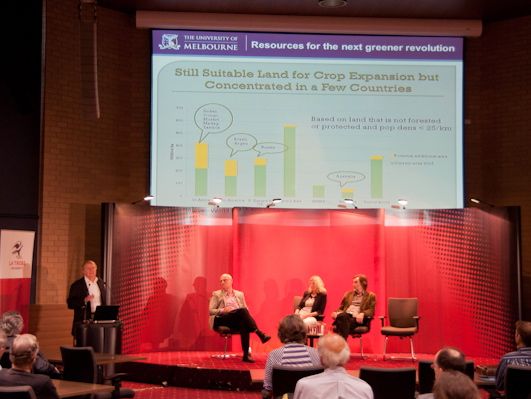This question may not mean a lot to you right now, but it will. By 2050 our population will have expanded by 2 billion – that’s a lot of extra people for dinner. But the concern raised by numerous agricultural and environmental scientists is that the mouths to feed will significantly outweigh the amount of food our earth can supply.
A group of scientists recently met at La Trobe University as part of the Ideas and Society’s Program to debate and discuss this pressing issue.
While disagreement transpired between the panel consisting of the CEO of World Vision Tim Costello, agricultural scientist Snow Barlow, Professor Phillip Keane from the Department of Botany, and science journalist Elizabeth Finkle, they all agreed on one thing: that solving this issue presents a huge challenge.
According to these academics the biggest cause for food scarcity is climate change. Whether you believe it or not, temperature and carbon emissions are significantly affecting our food sources, and the ability to adapt our agricultural land to global warming is no mean feat. The United Nations fears that severe weather in a key producing nations could see more people go hungry.
This fear stems from events like last year’s drought in the United States that devestated corn crops, and the 2011 Australian banana shortage caused by cyclone Yasi in Queensland. While not being able to afford to eat bananas for a year was a horrible experience for fruit lovers, the consequences for the farmers were much worse.
Phillip Keane argues that there is not enough incentive offered to farmers who are paid very little for their products. The average age of a farmer in Australia is 60 – an alarming figure. In order to grow food in the future our country needs farmers.
Keane suggests that produce needs to be traded at an adequate price in order to sustain farmers so they are able to grow more food. But there are many issues that are increasingly out of farmer’s hands such as losing farmland to erosion, soil degradation and even urban sprawl.
These types of demands are putting great pressure on our already scarce agricultural resources. Agriculture is forced to compete for land and water with urbanization, and adapt to climate change while helping to preserve natural habitats and protect endangered species.
Agricultural scientist Snow Barlow thinks that we can help curtail this issue by reducing need for extensive animal protein in our diet. If we simply lessen the need to farm livestock and increase the farming of rice it will be easier to feed the world, however, it is highly unlikely that this diet will be popular amongst the developed world.
But just how much spare land do we have to feed the world? The answer is, very little. Barlow acknowledges that during the Green Revolution from 1960-1990 the world was able to double its food production through the use of research, development, and technology such as fertilizer and irrigation. But she argues that this time round it will be much more difficult because the land area just doesn’t exist.
If this concern is the next global challenge, why hasn’t it been publicised in the media to the same degree as climate change? A simple Google search presents various articles written by alarmed academics questioning the likelihood of this issue being solved. One reason this challenge has not been on the agenda is due to Australia presently being an extremely food secure nation.
According to Snow, Australia’s current food source is able to feed 60-80 million people, much more than our current population. But we have a social and global responsibility due to the vast land we possess to assist the rest of the world. Right now Australia feels comfortable with our food security, but this can easily be affected by the aforementioned threats such as climate change.
Keane raises the argument that we are not adequately feeding one billion of our population now, with one in eight people in the world currently undernourished. This issue is due to an improper distribution of food rather than the inability of production. Large amounts of food are fed to animals and turned into bio-fuels, while about a third of the food we produce is wasted. Up to two billion tonnes of food are thrown away worldwide each year, which amounts to 50 per cent of total production.
We need to generate new technologies to grow more food from less land, with less human help, as well as curb our large waste issue. But can we do it? The La Trobe panelists believe we can, it just wont be an easy accomplishment.
 Bridget Rollason is a bachelor of journalism student and a staff writer for upstart. You can follow her on twitter @didgereidoo
Bridget Rollason is a bachelor of journalism student and a staff writer for upstart. You can follow her on twitter @didgereidoo







